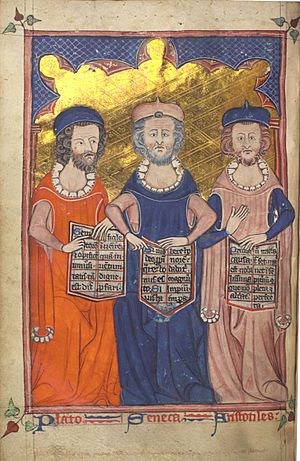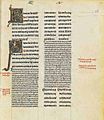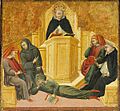Condemnations of 1210–1277 facts for kids
The Condemnations at the medieval University of Paris were rules made to stop certain ideas from being taught. These ideas were seen as wrong or dangerous by the Church. Many of these rules targeted old religious teachings. But most importantly, they aimed at the scientific writings of Aristotle, a famous ancient Greek thinker.
The Bishop of Paris was in charge of investigating these teachings. The most famous rules, called the Condemnations of 1277, are often linked to an investigation asked for by Pope John XXI. However, it's not fully clear if the Pope truly wanted a list of banned ideas.
About sixteen lists of forbidden ideas were made by the University of Paris in the 1200s and 1300s. Many historians believe the 1277 Condemnations were very important. They think these rules encouraged scholars to question Aristotle's science. Some even say these condemnations helped start modern science.
Contents
Early Rules: The 1210 Condemnation
The first major rule, the Condemnation of 1210, came from a church meeting in Sens. The Bishop of Paris was part of this meeting. Some medieval scholars' writings were banned, possibly because they seemed to suggest that God was everything (a belief called pantheism).
The rule also stated: "Books by Aristotle about natural philosophy or their explanations cannot be read in Paris, either in public or in private." Breaking this rule meant being kicked out of the Church (excommunication). However, this rule only applied locally. It also only affected the Arts faculty at the University of Paris.
Teachers of Theology (religious studies) were still allowed to read these books. The banned books were not even specifically named. It is thought that Alexander of Aphrodisias, who wrote about Aristotle, was one of the targets.
The University of Toulouse, founded in 1229, tried to attract students by saying: "Those who want to deeply explore nature can read Aristotle's books, which were forbidden in Paris." But it's not clear if the ban truly stopped the study of science books in Paris. English scholars like Robert Grosseteste and Roger Bacon studied in Paris. They could have gone to the University of Oxford, where Aristotle's works were openly discussed. It's believed that these books were still read privately in Paris. By 1240, there were signs that they were even discussed publicly again.
New Rules: The 1270 Condemnation
By 1270, the old ban on Aristotle's natural philosophy was mostly ignored. Still, Étienne Tempier, the Bishop of Paris, gathered some traditional religious thinkers. In December 1270, he banned the teaching of certain ideas from Aristotle and Averroes. Averroes was an Arab thinker who wrote about Aristotle.
Thirteen ideas were listed as false and against Church teachings. Some were about Averroes' ideas on the soul. Others were against Aristotle's idea of God as a passive "unmoved mover" (a first cause that doesn't change). The banned ideas included:
- "That all humans share one and the same mind."
- "That the soul, after leaving the body in death, cannot be hurt by physical fire."
- "That God cannot make something that dies become immortal."
- "That God does not know individual things or people."
- "That God does not know anything other than Himself."
- "That human actions are not guided by God's plan."
- "That the world has always existed."
- "That there was never a first human being."
Anyone who "knowingly" taught or said these ideas were true would be automatically excommunicated. This also hinted at the threat of the medieval Inquisition if they continued. It's not known who exactly taught these ideas. But Siger of Brabant and his group of thinkers at the Faculty of Arts were targets. These thinkers had taught that Aristotle's ideas were true in philosophy, even if they disagreed with religious beliefs. This was called the "doctrine of two truths." Topics like free will and the soul's immortality were debated. However, it seems "unthinkable" that any teacher would deny God's plan.

The Big One: The 1277 Condemnation
The events leading to Bishop Tempier's 1277 condemnation are still not fully clear. The Catholic Encyclopedia says that religious thinkers at the University of Paris were worried. They saw a conflict between Christian beliefs and some of Aristotle's ideas. According to historian Edward Grant, these thinkers wanted to ban Aristotle's ideas about the world being eternal and the mind being one for all.
On January 18, 1277, Pope John XXI asked Bishop Tempier to look into the complaints. "Tempier not only investigated but, in just three weeks, on his own power, he issued a condemnation of 219 ideas." These ideas came from many sources, including, it seems, the works of Thomas Aquinas, a very important Christian thinker. The list, published on March 7, banned many "errors." Some were from astrology, and others from the philosophy of Aristotle's followers. These included:
- 9. "That there was no first human, nor will there be a last. Instead, humans have always been born from humans and always will be."
- 49. "That God could not move the heavens in a straight line. The reason given was that an empty space (a vacuum) would be left behind."
- 87. "That the world is eternal in all its forms. And that time, motion, matter, and cause are eternal. And because the world comes from God's endless power, it's impossible for something new to appear without a new cause."
The punishment for teaching or listening to these errors was excommunication. People had seven days to turn themselves in to the bishop or chancellor. If they did, the bishop would give them a fitting punishment. The condemnation aimed to stop teachers from explaining Aristotle's works in ways that went against Church beliefs. Besides the 219 errors, the condemnation also covered Andreas Capellanus's book On Love. It also banned unnamed books on geomancy (fortune-telling by lines), necromancy (talking to the dead), witchcraft, or fortunetelling.
The 1277 condemnation was later partly canceled. This was done "as far as the teachings of Thomas Aquinas seemed to be included."
Why Was This Important?
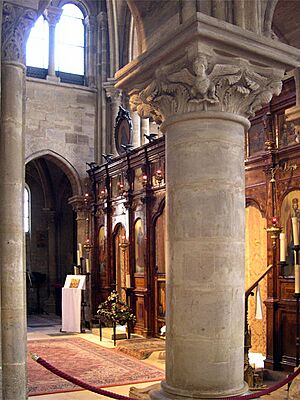
The long list of banned ideas has often been called unorganized. It was "broad in scope to the point of confusion." However, the order of the list might have been based on how the errors appeared in the books that were checked. The list was reorganized soon after 1277. This was probably to make it easier for scholars to use. In the 1900s, a historian named Pierre Mandonnet reorganized the ideas again. He numbered them and separated 179 philosophical ideas from 40 religious ones. The Stanford Encyclopedia of Philosophy also pointed out that "Tempier's ideas express positions that cannot be held in light of revealed truth." For this reason, each idea was followed by the word 'error'.
Another issue was that Tempier did not name the people he was condemning. He only said it was directed at unnamed members of the Arts Faculty in Paris. Siger of Brabant and Boethius of Dacia have been pointed out as the main targets of the 1277 ban. However, their names are not in the document itself. They only appear in notes in a few copies of the condemnation. These two scholars were important supporters of the Averroist movement. A study by historian Roland Hissette showed that many of the banned ideas seemed to come from Aristotle, Arab philosophers, or other Greek philosophers.
The role of Pope John XXI in leading up to the condemnations is a newer topic of discussion. Because the Pope's letter came only about six weeks before Tempier's condemnation, people used to think Tempier acted on the Pope's orders. They thought he acted too eagerly and quickly. However, more than forty days after Tempier made his list, another letter from the Pope showed no sign that he knew about Tempier's action. This suggests the opposite. So, it's possible that Tempier was already preparing his condemnations before getting the Pope's first letter. The Pope himself did not play a direct role. He only asked for an investigation. One scholar has argued that there was "less than enthusiastic papal approval of the bishop of Paris' actions."
How Did This Change Things?
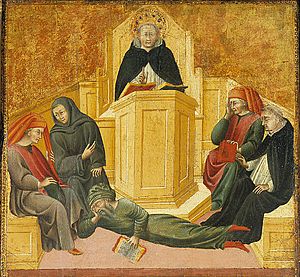
Historian Pierre Duhem believed these condemnations "destroyed some basic ideas of Aristotle's physics." Aristotle's system thought ideas like an empty space (a vacuum) were impossible. But believing in God's all-powerfulness made them seem possible. This was true while waiting for science to prove them. From at least 1280 onward, many teachers in Paris and Oxford agreed that nature's laws were against creating empty space. But they also said that such a space was not against reason itself. These arguments led to a part of mechanical science called dynamics.
Pierre Duhem and Edward Grant say this caused a break from Aristotle's work. It forced teachers to believe Aristotle's work was not perfect. According to Duhem, "if we must pick a date for the start of modern science, we would, without a doubt, choose the year 1277." This was when the Bishop of Paris officially said that many worlds could exist. He also said that the whole heavens could move in a straight line without a problem.
Duhem's view has been very important in the history of medieval science. It helped make it a serious field of study. "Duhem believed that Tempier, by stressing God's absolute power, had freed Christian thought from blindly accepting Aristotelianism. In this way, it marked the birth of modern science." The condemnations certainly helped science. But scholars disagree on how much they influenced it. Historians today no longer fully agree that modern science started in 1277. Edward Grant's ideas are closest to Duhem's, but Grant's are more detailed. What historians do agree on is that the condemnations allowed science "to think about possibilities that the great philosopher never imagined." According to historian Richard Dales, they "definitely seemed to encourage a freer and more imaginative way of doing science."
Other thinkers point out that in philosophy, a critical and questioning reaction followed the 1277 Condemnations. Since religious thinkers had said Aristotle was wrong in theology, and showed the bad results of accepting his ideas without question, scholars like Duns Scotus and William of Ockham (both Franciscan friars) believed he might also be wrong in philosophy. The ideas of Scotus and Ockham led Scholasticism (a way of thinking and teaching) in a different direction. The religious reasons for their philosophical arguments can be traced back to 1277. They emphasized the traditional Franciscan ideas of God's all-powerfulness and freedom. These ideas were part of Ockham's first main point.
Ockham's second main point was the principle of simplicity, also known as Ockham's razor. This led to a new way of thinking, based on learning through experience. As David Lindberg writes, "While it was set in the Scholastic world, it was completely modern in its focus." This new way of thinking was called the via moderna (modern way). It was against the via antiqua (old way) of earlier scholars. It has been seen as a step towards a modern age of analysis. Other, even more questioning thinkers in the mid-1300s included John of Mirecourt and Nicholas of Autrecourt. It has been suggested that the new philosophy of nature that came from the rise of Skepticism (doubt) after the Condemnations contained "the seeds from which modern science could grow in the early 1600s."
Images for kids
-
A 16th-century picture showing doctors meeting at the University of Paris.
-
A French book from the late 1200s with Averroes' notes on Aristotle's De Anima.
-
Inside the Saint-Julien-le-Pauvre church, once a part of the University of Paris's School of Theology and Arts.
-
Giovanni di Paolo's painting showing St. Thomas Aquinas debating Averroes. Bishop Tempier looked into the ideas of both Aquinas and Averroes.
See also
- History of Science in the Middle Ages
- Medieval university
- Renaissance of the 12th century


